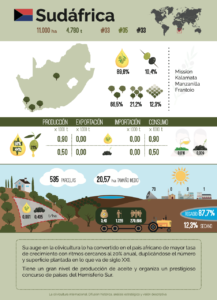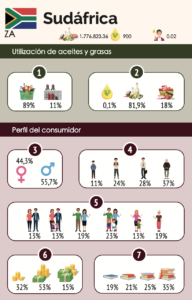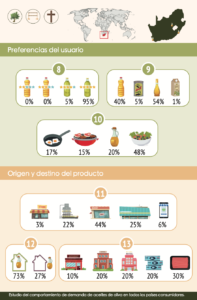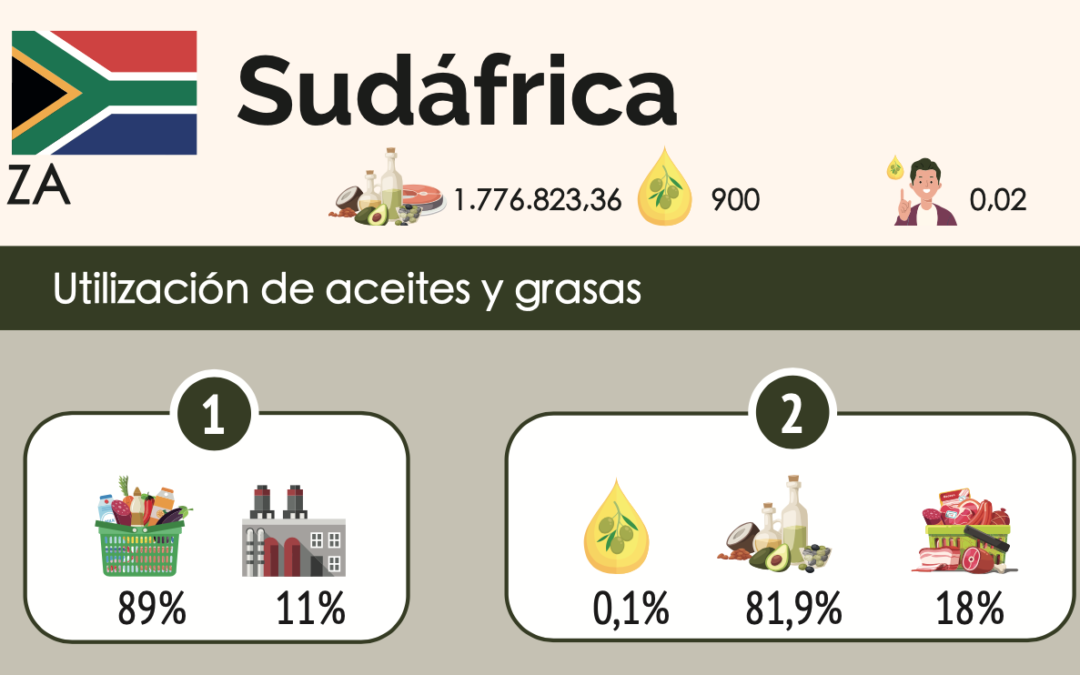South Africa is known for its diversity of cultures, languages and religious beliefs, which is why it is known as the rainbow nation.
Olive cultivation in South Africa is relatively recent, with the first olive trees known to have been planted around the middle of the 17th century, but it was not until the beginning of the 20th century that olive growing began to gain importance thanks to the importation of olive trees by the Italian Fernando Costa around 1900, from which time the development of the olive as an industrial crop began.

Olive growing has boomed in recent years, making South Africa the African country with the highest growth rate, with annual growth rates close to 20%, doubling the number and area planted so far in the 21st century.
South Africa currently has 3.600 hectares of olive groves, ranking 33rd in terms of area, representing 0.09% of the world’s olive grove area.
Almost 95% of the total planted olive grove area is located in the Western Cape province. It is characterized by a Mediterranean climate with cool, wet winters and hot, dry summers, which makes it very suitable for olive growing. The 3% is located in the Eastern Cape, with approximately 4% of the total South African olive groves.
There are two distinct types of olive orchard owners, those who own large tracts of land with more than 50 hectares. This first group brings together several links in the olive value chain, since they harvest the olives, transform them into oil and market it. On the other hand, there are small producers with less than 5 hectares of olive groves.
There are currently 535 plots, with an average size of 20.57 hectares. The productivity of the farms is low, with an average production per hectare of 91 kg/ha, equivalent to 19.11 kg/ha of olive oil.
The most widespread type of olive grove is conventional, representing 66.5% of the area. The remaining 33.5% is modern olive groves, 21.2% of which are modern intensive olive groves and the remaining 12.3% modern super intensive olive groves. Most of the area is irrigated, 87.7% of South Africa’s olive groves and the remaining 12.3% is rainfed. The main varieties grown are Mission, Kalamata, Manzanilla and Frantoio.
In the industrial sector, there are 70 oil mills located in South Africa and one bottling plant. There are no olive oil mills or refineries. In the past, most of the production was destined to table olives, but nowadays it has been reversed, and only 10.4% of the olive harvest is dedicated to canned olives, while 89.6% is dedicated to olive oil. Of the total olive oil produced, 56% is virgin and extra virgin olive oil and 44% is lampante olive oil.
Local production is relatively small, so South Africa imports bottled and bulk olive oil mainly from Spain and Italy, but also to a lesser extent from Greece, Portugal and Argentina. Bottled olive oil comes mainly from Italy, due in part to the large presence of Italians in the country who are large consumers of Italian olive oils.
In economic and employment terms, the olive oil sector generates 3.4 million euros and provides almost 280,000 real working days, which translates into 1,230 permanent jobs.
Olive oil consumption in South Africa is very low compared to countries with a long olive oil tradition. Only 900 tons of olive oil are consumed, which represents 0.03% of the total olive oil consumed in the world. The average consumption per person per year is 0.02 kg, which is far below the world per capita consumption of 0.45 kg.

Of the total animal and vegetable fats consumed in the country, 0.1% is olive oil, 81.9% vegetable fats and 18% animal fats.
Most of the olive oil is for human consumption, 89%, and the remaining 11% is for industrial use.
The profile of the South African consumer is middle-income male, in greater proportion than female (55.7% compared with 44.3%), over 50 years of age (65%). Thirty-six percent of consumers are families with children, followed by childless couples (32%). 19% are single or widowed and 13% are single-parent families.
In terms of educational level, the largest consumers are those with a medium-high level of education, with secondary education (25%) and university education (35%).
Although it is not a country with a great olive-growing tradition, nor is olive oil produced in large quantities, consumers do give priority to the quality of the olive oil they consume. This fact is evidenced by the fact that 100% of the olive oil consumed is virgin olive oil (5%) and extra virgin (95%).
It is mainly purchased in glass containers (54%). And the main use of olive oil by the South African population is for raw consumption (48%), 20% for cooking, 17% for frying and 15% for grilling.
The establishment where it is mostly purchased is in supermarkets (44%) and hypermarkets (25%), followed by purchases directly from the mill (22%). 6% is purchased over the internet and the remaining 3% is purchased in traditional stores.

Most of the South African population consumes olive oil inside the home (73%) and the remaining 27% outside the home. Of the oil consumed outside the home, most is consumed in the food processing industry (30%). 20% is consumed in the canning industry, 20% in hotels, and another 20% in communities such as schools, hospitals, etc. Finally, 10% is consumed in restaurants.

